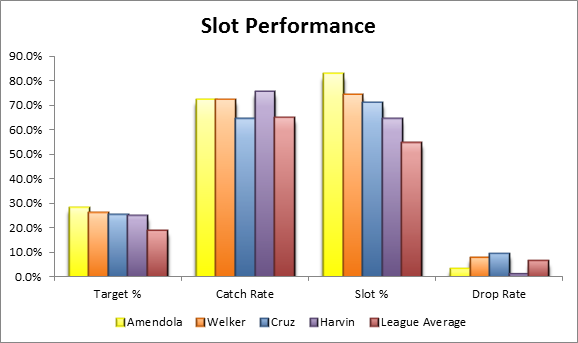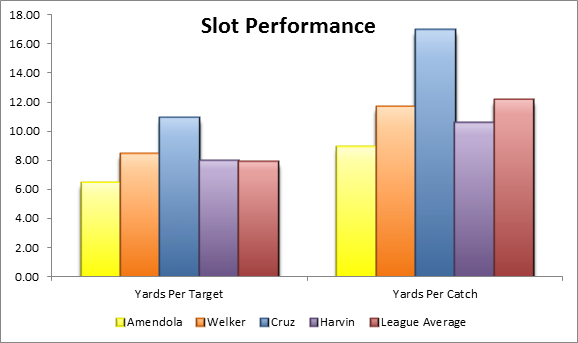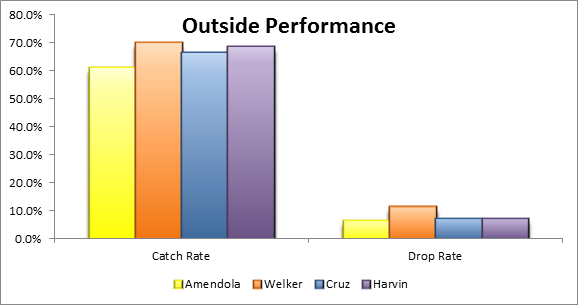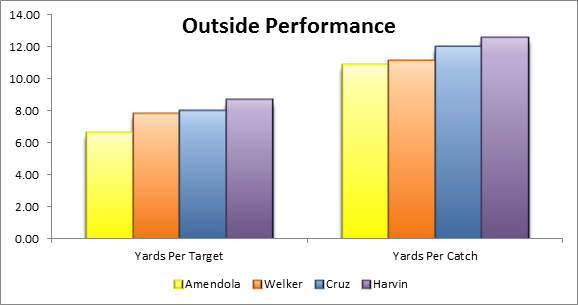[adsenseyu1]
Yesterday WR Victor Cruz did an interview in which he said he felt as if he was underpaid and insinuated that the only reason he accepted the deal to stay with the Giants was to stay close to home. So let’s examine the situation a bit more in depth.
Now I think most people would agree that Cruz handled his negotiations poorly. He made his desire to stay in NY well known which immediately gave the Giants even more leverage, something that they already had an abundance of because of Cruz’ status as a Restricted Free Agent. He switched agents during the process somehow getting mixed up somewhat in the whole Jay Z mix, which only led to him reiterating he did not want to leave NY. In doing so went from being the biggest priority for a small firm to just one of many names in a large firm. He signed his RFA tender, a move some (not all) would have advised against, rather than threatening a holdout. At the end of the day many sources claimed that Cruz ended up signing the same deal the Giants had on the table for him the year before.
That being said, I can understand Cruz’ statements and part of the problem can be the management of expectations by advisors around him. When you look at the salary scales and see players like Mike Wallace earning $12 million a season you have to wonder why you are only making $8.6 million a season. Cruz’ problems, beyond what was outlined above, are that he is primarily a slot receiver and that he is an incredibly specialized slot receiver at that.
Slot receivers are paid far less than players on the outside. That’s just the way the game works. Comparing Cruz to Wallace is essentially the same as comparing Jimmy Graham to Wallace. The position is valued differently, because of expectations and difficulty in finding players to play the two receiving roles. Now the Seahawks burst the market for a player who most would typecast a slot receiver in Percy Harvin. While some may argue Harvin can do more than just catch, it’s really just an outlier of a contract. The real market is much lower than Harvin.
There is no escaping the slot stigma for Cruz. There were only 21 players last season that had at least 300 routes of which at least 50% of them came in the slot. Cruz was one of them with about 70% of his routes coming in the slot. When lining up outside, Cruz numbers dramatically fell. As a slot target Cruz’ YPC average was 15. On the outside the YPC fell to 8. Cruz could argue that his numbers were better the year before but the counter from any team would be that nobody was prepared for Cruz and 2012 represents a more realistic performance. His only way to prove otherwise was to play the year out, which he was unwilling to do.
As a slot performer there were few more productive. On a yards per route basis only Randall Cobb of the Packers was slightly better. Cruz was 12% more productive than Wes Welker, third among slot players, and far more productive than anyone else at the position. He battled some drop problems but so did Welker and Cobb, so it’s not like Cruz was that terrible in that regard, something people make him out to be. I think it would be fair to say that based on two years of play none are better in the league who play in the slot. However, he is still just a slot receiver.
A difficulty for Cruz is that his skills are unique, something not that uncommon to the position. A player like Welker is typecast because he is short and plays in an offense with a superbly accurate QB that looked his way far more often than most would due to the lack of outside threats. Interest in Welker outside of New England was lukewarm. Cruz is just as specialized, simply in a different way.
Cruz plays with a QB who is going to the Hall of Fame and likes to throw the football down the field. Eli Manning is not the most accurate of players and meshes perfectly with Cruz who is not the most accurate of route runners. They work in an offense that is designed with that in mind and takes their fair share of chances with the football. Cruz isn’t going to fit in an offense with Christian Ponder or Alex Smith playing QB. He might not even fit with Tom Brady at this stage of Brady’s career.
Just as how Welker had problems, Cruz might have had similar ones in free agency. You need a stronger arm QB, an offense not afraid to let him use it, and an offense that doesn’t typecast its players, i.e. slot is a possession only receiver. Off the top of my head I would view the Colts, Ravens, 49’ers, Saints, and Cowboys as teams that would do that. Neither Dallas nor New Orleans have money to spend nor spots to fill. The Ravens would be hard pressed for cash as well so it’s a limited market. I’m sure some other teams would get in the mix too, but he likely isn’t a plug in anywhere player.
Cruz, at $8.6 million a year, is the highest paid slot receiver in the NFL. Miles Austin might be considered a slot player now (about 70% of his routes come from the slot, the same as Cruz last year) and makes $9 million a year, but when signed he was considered an outside threat. Cruz will earn about 18.5% more on an annual basis than Marques Colston of the Saints and 43% more than Welker. While those players are both older than Cruz, who will be 28 when his extension years kick in (Colston was 29 during his season of signing and Welker will be 32 in his), Cruz’ deal is worth more money than both and Colston in particular has shown the ability to play a bit more on the outside as well.
The other players who fit into the slot category with Cruz simply don’t make that much money. Cobb will see a payday soon, but guys like Santana Moss and Reggie Wayne are at the end of their careers while names like Jeremy Kerley, Davone Bess, Emmanuel Sanders, etc… are all on low cost deals and none of whom will break the bank when they hit free agency (Bess already signed for under $3 million a year).
Maybe Cruz is a victim of circumstance and will prove he can do more than what he has been asked to do so far. If that is the case I think he will have a strong argument that he is underpaid. But for the player that he is now and job he is asked to do he is very close to the right number. If he and his team had been a little more difficult on the Giants he probably could have pushed beyond $9 million a season, but even then it’s not the mega dollars that it sounds like Cruz feels he should have gotten. All told Cruz is pretty much right at what the market would be expected to pay for his services.
[subscribe2]
[adsenseyu2]




